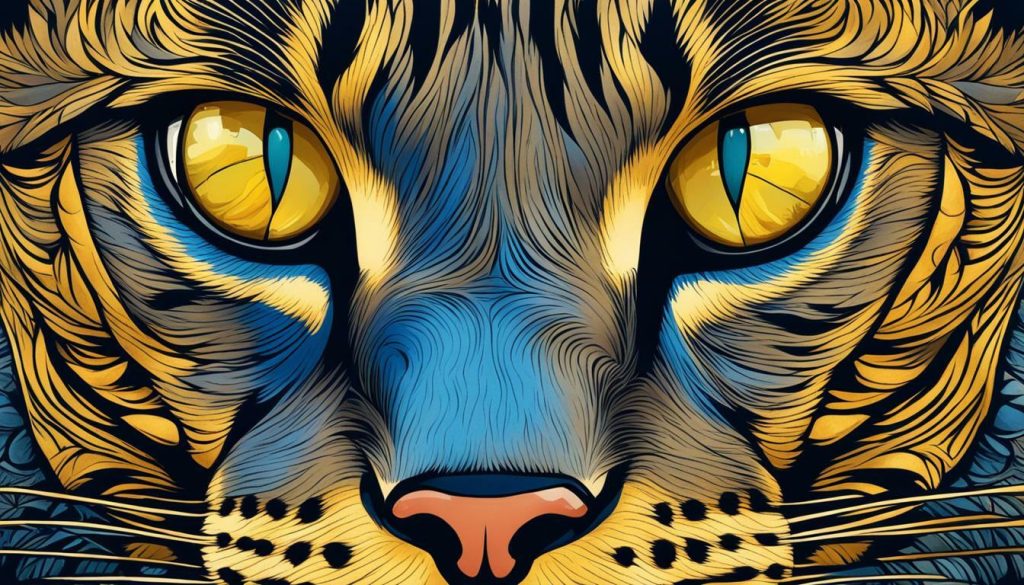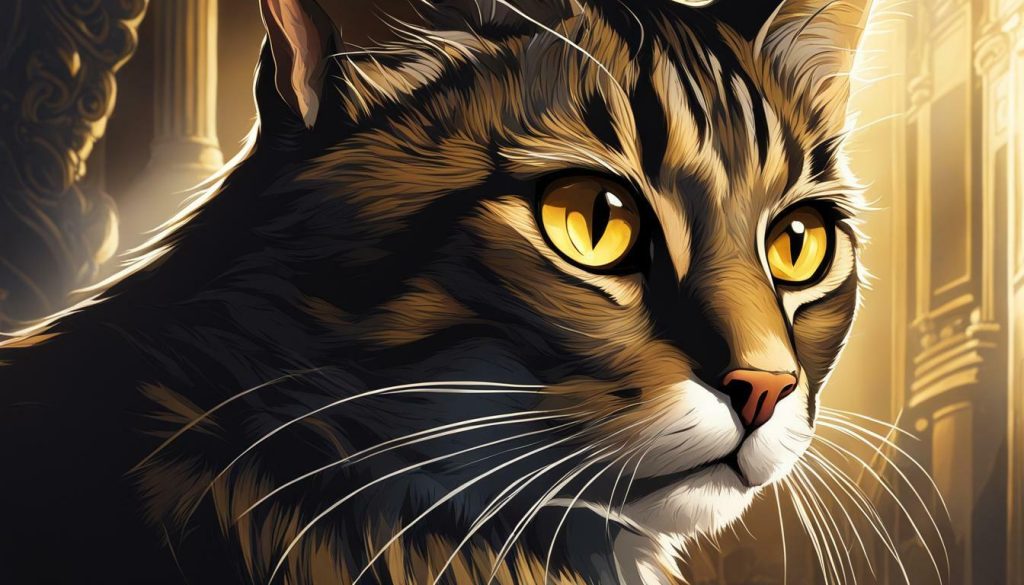As a cat owner, you may have noticed a change in your feline friend’s eye color over time. Perhaps you’ve observed a transition from blue to yellow eyes and wondered why this occurred. Cat eye color change is a fascinating phenomenon influenced by various factors, including genetics, age, health conditions, and environmental factors.
In this section, we will explore the reasons behind the transition from blue to yellow eyes in cats, including the genetics of feline eye color and the factors that can influence cat eye color change. By the end of this section, you will have a better understanding of why your cat’s eyes have undergone this change, and what this tells us about the uniqueness of feline genetics.
- 1 Key Takeaways:
- 2 Understanding Feline Eye Color Genetics
- 3 Factors Influencing Cat Eye Color Change
- 4 Blue to Yellow Eye Color Transition in Cats
- 5 Conclusion
-
6
FAQ
- 6.1 Q: Why do cat’s eyes change color?
- 6.2 Q: Can blue-eyed cats’ eyes change to yellow?
- 6.3 Q: Is cat eye color change a cause for concern?
- 6.4 Q: Can cat eye color change back to blue?
- 6.5 Q: Are all cats’ eye colors determined by genetics?
- 6.6 Q: Can a cat’s eye color change indicate a health problem?
Key Takeaways:
- Feline eye color change is a fascinating phenomenon influenced by genetics, age, health conditions, and environmental factors.
- The transition from blue to yellow eyes in cats is determined by the pigmentation layers within the iris.
- Cat eye color genetics play an essential role in determining eye color.
- Understanding the mechanisms behind feline eye color change can help us appreciate the beauty and uniqueness of our cats’ eyes.
Understanding Feline Eye Color Genetics
As a cat owner, you may have noticed changes in your feline friend’s eye colors over time. Understanding the genetics behind these color changes can help explain why cats exhibit different eye coloration patterns.
Cat eye color is determined by genetics. Specifically, the types and amounts of pigments that are present in the iris of the eye. The iris is the colored part of the eye that is responsible for controlling the size of the pupil. Pigment that is responsible for eye color is produced by specialized cells in the iris called melanocytes.
The color of the eye is determined by the type and amount of melanin present in the iris. In cats, melanin comes in two types: eumelanin (black or brown) and pheomelanin (yellow or reddish-brown). The color of the eyes can range from blue to green to yellow, depending on the presence and distribution of these pigments.
The inheritance of eye color in cats is complex, involving more than one gene. Different genes regulate the amount and type of pigment produced in the iris. The way that these genes interact with one another determines the final eye color of a cat.
While genetics is the primary driver of eye color, other factors can also play a role. Aging, illness, and injury can all cause changes in the color of a cat’s eyes. Additionally, exposure to certain chemicals or medications can lead to alterations in iris pigmentation.
By understanding the basics of feline eye color genetics, we can appreciate the complexities of this fascinating biological process. It also helps us appreciate the beauty and diversity of our furry feline friends’ eyes.
Factors Influencing Cat Eye Color Change
As I mentioned earlier, cat eye color change is influenced by a variety of factors. In addition to genetics, environmental and health conditions can also play a role in the transition from blue to yellow eyes.
Age is one factor that can cause feline eye color change. Kittens are often born with blue eyes, which gradually transition to their adult color over time. As cats age, their eye color can continue to change, with blue-eyed cats sometimes transitioning to green or yellow eyes.
Health conditions can also contribute to cat eye color change. Certain diseases, such as diabetes and hyperthyroidism, can cause changes in pigmentation that lead to a shift in eye color. Additionally, eye injuries or infections can result in a change in eye color as the iris heals.
Environmental factors, such as diet and sun exposure, can also influence feline eye color. A lack of certain nutrients or exposure to excessive sunlight can cause the pigmentation in the iris to shift, resulting in a change in eye color.
While genetics may be the primary factor in determining cat eye color, it is clear that other factors can have an impact as well. By understanding these factors, we can better appreciate the unique and ever-changing beauty of our feline companions.
Blue to Yellow Eye Color Transition in Cats
As mentioned earlier, cat eye color is determined by genetics, specifically the amount and distribution of melanin pigment in the iris. When a kitten is born, their eyes are typically blue due to the lack of melanin. However, as they age, their eye color may shift to yellow.
The transition from blue to yellow eyes in cats involves a gradual increase in the production of melanin, particularly the pigment responsible for yellow or orange hues called pheomelanin. This shift in melanin production results in the gradual change in the cat’s eye color from blue to yellow.
The most common time for a cat’s eye color to change is between the ages of three months to six months. However, in some cases, this change can occur even up to a year of age.
It is important to note that not all cats will experience a transition from blue to yellow eyes. Some cats may maintain their blue eye color throughout their life, while others may transition to green, gold, or even copper-colored eyes.
Environmental factors such as light exposure and health conditions can also influence the transition from blue to yellow eyes in cats. For example, cats that spend more time in the sun may produce more melanin, resulting in a faster change in eye color. Additionally, certain health conditions such as inflammation or injury to the eye can also result in a change in eye color.
Overall, the blue to yellow eye color transition in cats is a natural and fascinating process influenced by a variety of factors. By understanding the mechanisms behind cat eye color change, we can appreciate the beauty and uniqueness of our feline friends’ eyes.
Conclusion
I hope this article has shed some light on the intriguing phenomenon of cat eye color change, specifically the transition from blue to yellow. As we have discovered, genetics play a significant role in determining feline eye color, but there are also numerous other factors at play.
Age, health conditions, and environmental influences can all contribute to a shift in eye color, resulting in the beautiful and unique appearance of our cats’ eyes.
So, why do cats’ eyes change colors? The answer is complex and multifaceted, but the beauty of our feline friends’ eyes is undeniable. By understanding the mechanisms behind the transition from blue to yellow eyes in cats, we can appreciate their striking appearance even more.
FAQ
Q: Why do cat’s eyes change color?
A: Cat eye color can change due to a variety of factors, including genetics, age, health conditions, and environmental influences.
Q: Can blue-eyed cats’ eyes change to yellow?
A: Yes, it is possible for blue-eyed cats to develop yellow eyes as they age. This is a natural process and often occurs due to changes in pigmentation within the iris.
Q: Is cat eye color change a cause for concern?
A: In most cases, cat eye color change is a normal occurrence and not a cause for concern. However, if the change is sudden, accompanied by other symptoms, or if you have any concerns about your cat’s eye health, it is best to consult a veterinarian.
Q: Can cat eye color change back to blue?
A: Once a cat’s eye color has transitioned from blue to yellow, it is unlikely to change back to blue. The change in eye color is typically permanent and part of the natural aging process.
Q: Are all cats’ eye colors determined by genetics?
A: Yes, cat eye color is primarily determined by genetics. The specific combination of genes inherited from the parents determines the color and patterns in a cat’s eyes.
Q: Can a cat’s eye color change indicate a health problem?
A: While cat eye color change is typically a normal process, sudden or drastic changes in eye color could potentially indicate an underlying health problem. If you notice any concerning changes in your cat’s eye color, it is recommended to consult with a veterinarian for proper evaluation.












